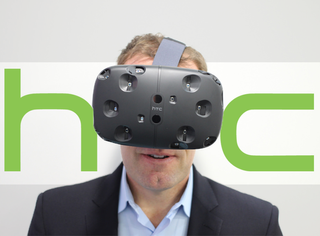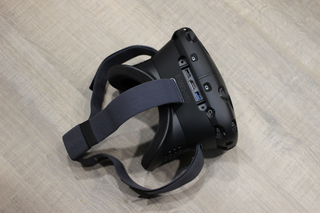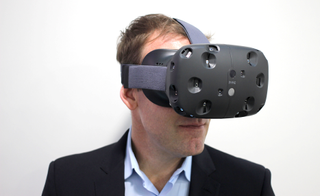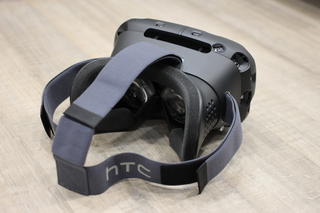HTC: Why Vive Will Beat Oculus VR at Its Own Game
HTC's executive director of marketing talks about the Vive's secret weapon against the Oculus Rift and the future of virtual reality.


I've tried a bunch of virtual reality headsets, from the Oculus Rift to the Gear VR, but there's nothing like the HTC Vive. I demoed HTC's virtual reality headset for the first time this week, and thanks to the headset's room-scaling capability, I could walk around underwater while getting up close and personal with a whale, peek around the painting I just made in midair with two motion-tracked controllers, and fix a broken robot by pulling all sorts of levers.
Jeff Gattis, HTC's executive director for marketing and emerging devices, is banking on this unique room-scaling and location-tracking feature as a "huge differentiator" to beat Oculus in the minds of shoppers. HTC also happens to have a first-mover advantage, as its PC-powered device will hit the market this holiday season; the Rift won't debut until 2016. (Pricing and other details for the Vive will be announced in October.) But will the Vive offer enough to win over early adopters?
I sat down with Gattis to talk about the VR competition, why HTC's partnership with Valve is so critical and where virtual reality is going. For Gattis, live-action capture will open up a whole new world of possibilities, putting you behind home plate at Yankee Stadium or in the middle of a concert as it's happening. And he said he thinks it will happen sooner than five years.
Tom's Guide: How much will the Vive be focused on gaming versus other content?
Jeff Gattis: I think Valve obviously brings great relationships in the development community and a bunch of enthusiastic developers who now have their kits and are starting to submit their plans and are starting to build their apps. I think you'll see an outsized portion of the content be game-related, but not all of it.

But a big part of the demo was to show the breadth of options, and that doesn't even touch on some more training-oriented things or this notion of live-action capture where you're at a concert or a sporting event. It's maybe a little further away, but they're not five years away. So I think it's important to show this diversity. For HTC, it's about cultivating these relationships in entertainment and other venues outside of gaming to complement our portfolio.
TG: What reasons would you give those who have been waiting for the Oculus Rift to opt for the Vive instead?
Gattis: I think everything I've seen that's out there is interesting, is cool and has market viability. I think it's good for the industry to have a Sony in this market, an Oculus in this market, an HTC and Valve in it. That means it's real. And that's been a difference from the past where there's been one little hobbyist that's trying to go in there.

I think from a consumer point of view, what we'll continue to highlight is just the depth and the immersiveness of our experience. We do think that room-scale capability, that ability to walk around the room, really adds an element that we haven't seen anywhere else in terms of the immersiveness. Wait until developers have more time and opportunity to think how to really take advantage of that. So we think that's a huge differentiator.
MORE: VR Headset Mega Guide: Features and Release Dates
We also think the backing of Valve, our stream-VR platform for delivering this content, the relationships they have in the gaming community are really going to give us a leg up in terms of our content library.
We're obviously biased, but we think we have the highest specs, the highest-precision tracking, and that room-scale capability is a great differentiator. We are confident that it's a great experience. We'll have to see where the market goes.
TG: For the room tracking, what if you have a coffee table? Can the Vive sense other objects or just the wall?
Gattis: We know that not everyone has a perfectly square, 15 x 15[-foot] room, so there are a lot of things in the software that are in there now, and the team is working very hard to create that out-of-box experience where essentially we can configure your room for you. So you'll look around, put on the headset, and we'll have you walk — it's a one-time setup — and identify objects in that room. If there's a table over here or a wall that juts out or something, we can track all that stuff. You basically click Save Configuration. Now we know what your room is and we can build it accordingly.
You'll get warnings if you're about to walk into something. I think you might have also seen the front-facing cameras on the HMD [head-mounted display]. That is really to identify if you have a small pet that walks in front of you. It will actually alert you to that and say don't step there.
How do you overcome the geek factor with VR headsets?
Gattis: I think you do it with content. I think it's like any new product that comes into market. There's a little bit of a learning curve. A few years ago, it was awkward to be talking into one of these [points to big-screen phone], and now people are beginning to adapt to it. It's still kind of an awkward behavior to be walking around playing with your smartwatch.

In my opinion, three years from now, the idea of putting something on your head will be an accepted practice. And that something you put on your head might look a lot different than what you put on your head today. Obviously, if you are looking 10 years out for VR, that factor might be quite different. … It might be glasses. It might be something much smaller.
TG: What excites you most about the VR category in terms of where it can go and the types of experiences it can enable?
Gattis: What excites me about it is as it moves beyond gaming. I think in the short run, I can go someplace I couldn't go previously, so maybe I can walk on the moon, maybe I'm on a safari in Africa, or in that Blue demo where I'm under the water, maybe I'm swimming with sharks. All things that are relatively easy can be brought into this environment but feel so immersive that you actually feel like you're there without getting on an airplane.

From more of a personal point of view, I think this idea of live-action capture is really interesting. I don't think the technology in the industry is quite there yet, but there are some companies doing some very interesting things around capturing live footage and stitching it together on the fly. Where for me, the promise of it as a big sports fan is to sit behind home plate at Yankee Stadium, or maybe I'm actually sitting in the third-base coach's box watching the game. Maybe I'm doing all of those. … I can bounce around to different viewpoints, but I have this completely immersive experience where I can see the crowd. I see exactly what I would be seeing if I was on the field or walking out of the tunnel at the Super Bowl. These things are very possible, very real things that are going to happen.
TG: Is live-VR-action capture and streaming possible within the next five years?
Gattis: I think less than that. Already there are companies like Next VR and others that have done pilots with the NBA. Again, it's not live streaming, but this technology is rapidly evolving. And so whether it's that or it's a concert, being able to sit on stage or walk backstage, it's very possible. I'd say in the two- to three-year time frame, maybe even closer to the low end of that. So that to me is the promise when you start talking about taking this from the gamer, maybe a little bit of a niche, to making this more mainstream to where my mom is interested in this. She likes to watch the baseball games.
TG: What's your take on the differences between augmented reality and virtual reality?
Gattis: I think there is room for both. I tend to think they are largely different experiences. There's some commonality in that there are elements of virtual experience that are emulating the real world. To me, AR is very compelling. When I look at some of the use cases for AR, I think of things where I'm looking at you and I can see metadata on you maybe, a bubble above your head that tells me who you are and where you live, when you were born, that kind of thing.

Maybe I'm at a baseball game, maybe I'm watching TV, but I'm watching Alex Rodriguez bat and I see all of his statistics next to him while I'm sitting in the stadium. So I guess I see a lot of those scenarios. That mixed reality of walking around and seeing a building and knowing what the building was and when it was built, etc. VR is much more about taking you out of that experience and taking you into a new world. So maybe it's more entertainment-inclined because it's an escape, but it's still emulating, it's still giving you that feeling that there is some realism to it.
TG: Because you're a mobile company, do you see yourself venturing into that space for VR?
Gattis: I will say that our next step will be looking at different types of VR, starting with this, which we think is the optimal experience. A logical next step for us to investigate is a mobile phone-powered solution for the gear and even down to the [Google] Cardboard experience. I think there are these different tiers of VR. We want to be a player across the board in VR, not just in hardware, but [also] in other pieces of it, whether that be content development, distribution of content. We are obviously looking at a lot of different things. This is a big, viable business for us. Not just being a hardware player.
TG: What does the Vive mean for HTC overall? This isn't the first time you've branched out beyond smartphones, but this seems like a much bigger deal.
Gattis: I joined the company about a year ago, and it was really as we kicked off what we call this "Connected Product Business Unit," and the whole mission was to diversify our business portfolio and how to expand into some of these new markets beyond the smartphone. Obviously, the Re camera was the first step in that direction, but now we have started a strategic partnership with Under Armour, we are going into the health and fitness wearable space. We are very excited about that. You'll see a lot more about that later this year.
But yes, we believe that virtual reality is going to be a huge market, and through our partnership with Valve, it's become really important. The response when we were in San Diego with our truck at Comic Con was overwhelming, to where a lot of people were like, "Wow, HTC's involved with this? I didn't know."
Our goal with all these connected products is to take HTC's brand from, "They make great smartphones," to, "great consumer technology company that makes VR." They make smartphones. They make wearables.
- Wearing HoloLens: The Future of Computing on My Face
- Gear VR for Galaxy S6 Review - May Induce Awesomeness
- The Best Headsets for Immersive Gaming
Follow Editor-in-Chief Mark Spoonauer at @mspoonauer. Follow Tom's Guide at @tomsguide, on Facebook and on Google+.
Image credits: Maurizio Pesce, Flickr.com. Lead composite: Kenneth Butler, Tom's Guide.
Sign up to get the BEST of Tom's Guide direct to your inbox.
Get instant access to breaking news, the hottest reviews, great deals and helpful tips.
Mark Spoonauer is the global editor in chief of Tom's Guide and has covered technology for over 20 years. In addition to overseeing the direction of Tom's Guide, Mark specializes in covering all things mobile, having reviewed dozens of smartphones and other gadgets. He has spoken at key industry events and appears regularly on TV to discuss the latest trends, including Cheddar, Fox Business and other outlets. Mark was previously editor in chief of Laptop Mag, and his work has appeared in Wired, Popular Science and Inc. Follow him on Twitter at @mspoonauer.
